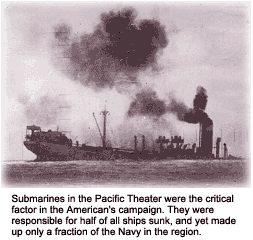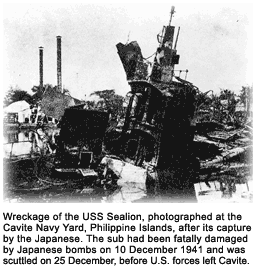"Execute unrestricted air and submarine warfare against Japan."The attack on Pearl Harbor was Japan's calculated attempt to gain the upper hand against America's increasing confrontation with the Japanese empire. Much of the Pacific U.S. surface fleet was ravaged. However, the Japanese aircraft barely touched the American submarine base — which historically proved to be a serious mistake.
- Admiral R. Stark, Chief of Naval Operations in Washington, December 1941.
Victory would exact a painful cost for Americans — U.S. losses totaled 3,506 men and 52 submarines in the Pacific Theater. Nevertheless, by the end of the war, U.S. submarines completely cut the supply lines to an island nation, a feat that German U-boats failed to do in two world wars.
 Insight
Insight
During World War II, submarines comprised less than two percent of the U.S. Navy, but sank more than 30 percent of Japan's navy, including eight aircraft carriers. More important, American submarines contributed to the indirect decapitation of the Japanese economy by sinking almost five million tons of shipping — more than 60 percent of the Japanese merchant marine.
However, disharmony in command between the U.S. Pacific Fleet based in Pearl Harbor and the U.S. Asiatic Fleet in Manila for manpower and matériel accounted for infighting that lasted virtually throughout the entire war.
Gearing up
Twenty-nine U.S. submarines were stationed in Manila Bay and 21 lay at Pearl Harbor. Of the Manila boats, six were of the old S-class, seven were fleet submarines of the transitional P-class, and 12 were more modern fleet boats of the U.S.S. Salmon (SS-182) class.
Manila Bay units were commanded by Captain John Wilkes and serviced by two tenders and a converted merchant ship. The 21 submarines of the Pearl Harbor force, under Rear Admiral Thomas Withers, included six early V-class fleet boats, three P-class, and 12 new U.S.S. Tambor (SS-198) class submarines. When the war began, however, 11 of the Pearl Harbor boats were in the United States in various stages of overhaul.
 Manila
Manila
While General Douglas MacArthur was withdrawing southward into defensive positions on the Bataan Peninsula, Admiral Thomas C. Hart, commander of the Asiatic Fleet, also moved his surface forces south, out of range of Japanese aircraft on Formosa. That left only his submarines to oppose the coming onslaught, and by December 11, 22 of Hart's 29 boats had left Manila on their first war patrols, to seek and destroy the expected Japanese invasion forces.
On the 10th of December, a massive Japanese air raid on the Cavite Naval Station south of Manila, damaged the U.S.S. Sealion (SS-195) beyond repair. The Japanese also destroyed the Cavite repair facility and most of the torpedoes in storage there. The Sealion was the first U.S. submarine lost in World War II.
 Because of inexperience, poor military intelligence, bad torpedos, and bad luck, the Manila-based submarines sent out to oppose the Japanese invasion were almost totally ineffective. Patrolling the approaches to Luzon, many succeeded in making contact with enemy forces, but their 45 separate attacks sank only three freighters.
Because of inexperience, poor military intelligence, bad torpedos, and bad luck, the Manila-based submarines sent out to oppose the Japanese invasion were almost totally ineffective. Patrolling the approaches to Luzon, many succeeded in making contact with enemy forces, but their 45 separate attacks sank only three freighters.
Six U.S. subs managed to converge on the Japanese landings at Lingayan Gulf on December 22nd, 1941, but even so, the enemy stormed ashore with ease. Finally, with the fall of Manila clearly approaching, Captain Wilkes decided at the end of the year to abandon the Philippines and move his submarines south to Surabaja in Java.
East Indies
As the Asiatic Fleet retreated southward, the Japanese commenced to conquer the Philippines, Burma, Malaya, and Thailand. Britain’s great defense at Singapore prevailed on February 15th, leaving the Japanese to concentrate on the Dutch East Indies, where Celebes and Borneo had already been invaded a month before. Withdrawing under relentless Japanese pressure, U.S. submarines nevertheless attempted to curb the tide by concentrating off Japanese staging bases and attacking the invasion forces wherever they could be found.
On February 28th, 1942, despite the Navy’s courageous rearguard defense, the Japanese took Java in little more than a week after squashing the surface forces of the United States, Britain, the Netherlands, and Australia in the Battle of the Java Sea.
Midway difficulties
Tactical errors by the top brass and insufficient boat designs plagued the submarine fleet throughout the war. The conventional method that subs should be employed as a defensive weapon and a support facility for land-based military activities continued, despite a much-needed change.
In June 1942, 12 boats were assigned to picket duty in the defense of Midway Island. The ensuing Battle of Midway, from which the U.S. came away victorious, was certainly one of the most notable naval conflicts in history, and an extremely critical event during the Pacific war. Yet for U.S. submarines stationed around the island, their part became an exhausting and insufficient effort — subs were continually given orders to stalk the entrances of harbors and ports, while ignoring the Japanese shipping presence on high seas trade routes.
Of the dozen boats assigned to that defensive duty, only a quarter ever saw an enemy ship. Of that number, only one sub was in a position to fire any torpedoes — which failed to explode.
Torpedo failures, during the battle of Midway and earlier, were numerous and succeeded in hamstringing numerous skippers. After setting up ideal attacks, their torpedoes often detonated prematurely, missed completely, or didn't explode at all.
The BuOrd (Bureau of Ordnance) held firmly to the opinion that human error was the cause of the torpedo troubles, not a design flaw.
Improvements made
By August 1942, the first surface search Radar system was installed aboard a U.S. submarine. The SJ Radar, although still full of kinks, was a tremendous boost to navigation, surface vessel detection and location. In addition, the new Gato class boats (SS-212), were arriving on a regular basis to replace and reinforce those battle-weary subs that had been bearing the brunt of the war so far.
Fortunately, major intelligence advances were being made at that time by the United States in intercepting and deciphering Japanese communications. "Ultra," as it was known, gave U.S. code breakers the ability to forward critical information to submarine captains.
 In the fall of 1943, the torpedo dilemma became a thing of the past. Installation of an improved firing pin resolved the issue of malfunctioning torpedoes virtually overnight. The resulting dramatic increase in tonnage scores removed any doubt about the cause of the problem that had been haunting the submarine fleet during the first few years of the war.
In the fall of 1943, the torpedo dilemma became a thing of the past. Installation of an improved firing pin resolved the issue of malfunctioning torpedoes virtually overnight. The resulting dramatic increase in tonnage scores removed any doubt about the cause of the problem that had been haunting the submarine fleet during the first few years of the war.
Victory in the Philippine Sea
With torpedoes working now, and the arrival of newly commissioned subs, the U.S. submarine fleet began to improve considerably. As a result, the submarine fleet steadily inflicted punishing blows on enemy shipping — by the close of 1943, U.S. submarines had sunk more than 1,500,000 gross registered tons of Japanese merchants.
The early months of 1945 proved to be highly productive on a regular basis — Japanese supply lines were down to almost nothing, and U.S. submarine hunting grounds were becoming thin.
The Allied victory during the Battle of the Philippine Sea dealt a body blow to the Japanese military machine. Three of five Imperial Japanese Navy aircraft carriers were sunk (two by submarines) and the substantial loss of aircraft basically all but terminated the Japanese Naval air force.